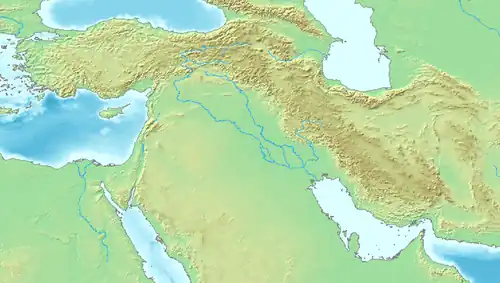| Enannatum I 𒂗𒀭𒈾𒁺 | |
|---|---|
| King of Lagash | |
 | |
| Reign | c. 2450 BC |
| Predecessor | Eannatum |
| Successor | Entemena |
| Dynasty | 1st Dynasty of Lagash |
Enannatum I (Sumerian: 𒂗𒀭𒈾𒁺, EN.AN.NA-tum2), son of Akurgal, succeeded his brother E-anna-tum as Ensi (ruler, king) of Lagash.[2] During his rule, Umma once more asserted independence under its ensi Ur-Lumma, who attacked Lagash unsuccessfully. After several battles, En-an-na-túm I finally defeated Ur-Lumma.[2] Ur-Lumma was replaced by a priest-king, Illi, who also attacked Lagash.
Enannatum had a son named Meannesi, who is known for dedicating a statue for the life of his father and mother.[3][4] He has two other sons, Lummatur, and Entemena, the latter succeeding him to the throne.[2] His wife was named Ashumen.[2]
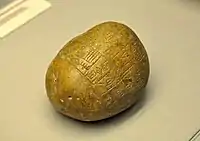 The cuneiform text states that Enannatum I reminds the gods of his prolific temple achievements in Lagash. Circa 2400 BCE. From Girsu, Iraq. The British Museum, London
The cuneiform text states that Enannatum I reminds the gods of his prolific temple achievements in Lagash. Circa 2400 BCE. From Girsu, Iraq. The British Museum, London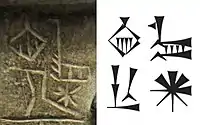 The name "En-annatum" in cuneiform
The name "En-annatum" in cuneiform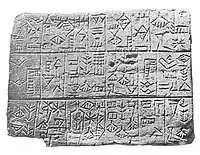
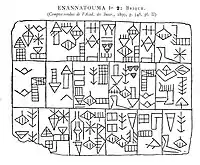
.jpg.webp) Mace head with the eagle of Lagash, dedicated to the life of Enannatum, possibly Enannatum II.[7]
Mace head with the eagle of Lagash, dedicated to the life of Enannatum, possibly Enannatum II.[7]_and_Enannatum%252C_the_British_Museum%252C_London..JPG.webp)
References
- ↑ "CDLI-Archival View". cdli.ucla.edu.
- 1 2 3 4 "Enanatum I". Cuneiform Digital Library Initiative. Oxford University.
- ↑ Bahrani, Zainab (2013). Women of Babylon: Gender and Representation in Mesopotamia. Routledge. p. 100. ISBN 978-1-134-60140-0.
- ↑ "Statue of Meannesi". cdli.ucla.edu.
- ↑ Sarzec, Ernest (1896). Découvertes en Chaldée... L. Heuzey. p. Plate XLVI.
- ↑ Sarzec, Ernest (1896). Découvertes en Chaldée... L. Heuzey. p. Plate XLVI.
- ↑ Art of the First Cities: The Third Millennium B.C. from the Mediterranean to the Indus. Metropolitan Museum of Art. 2003. pp. 75–76. ISBN 978-1-58839-043-1.
- ↑ Art of the First Cities: The Third Millennium B.C. from the Mediterranean to the Indus. Metropolitan Museum of Art. 2003. pp. 75–76. ISBN 978-1-58839-043-1.
This article is issued from Wikipedia. The text is licensed under Creative Commons - Attribution - Sharealike. Additional terms may apply for the media files.
